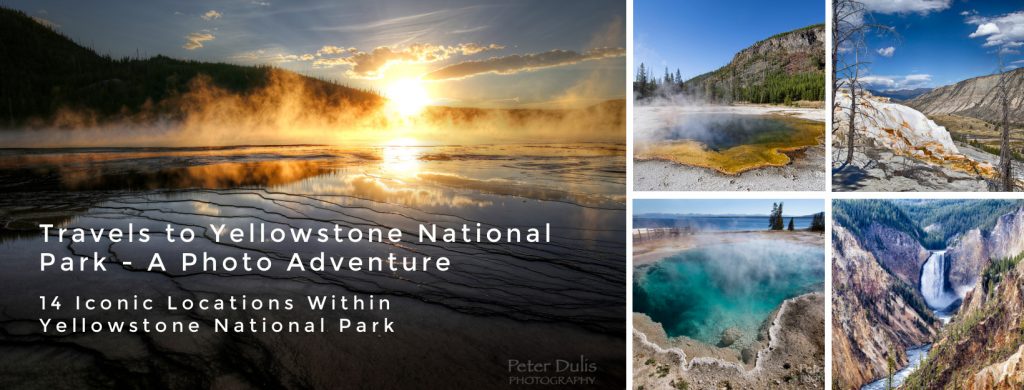
Travels to Yellowstone National Park – A Photo Adventure
(14 Iconic Locations within Yellowstone Park)
The world is full of amazing wonders. While the current pandemic has put travel on hold for now, we still dream of the next trip. With the start of a new year just around the corner, there is the promise of a return to travel. So, we are eager to share with you our journey to Yellowstone Park.
Yellowstone National Park is a photographer’s paradise in so many ways. This is a place that I’ve always wanted to visit for its sheer beauty. From the geysers, steam vents, hot springs and unique animals, to the Grand Canyon of Yellowstone Park, this place has it all. I must admit I was a little nervous just as we were about to board the plane a few years ago. The realization that this park sits on top of a super volcano, made me have second thoughts, but we pressed on for the adventure of a lifetime. We stayed at the Old Faithful Inn in the centre of the park, which I highly recommend because its central to many of the attractions.
Whether you’re an amateur iPhone user trying to capture your best photo for Instagram or whether you’re a professional photographer, knowing the best locations to photograph will be very helpful. Read on to discover the 10 best locations in Yellowstone Park to capture those iconic photos and how, when, where to capture the colors and beauty of this one-of-a-kind place. Feel free to share this article with a friend.
Hope you enjoy the photos!
All photos were taken with either my Canon EOS 6D camera using a collection of my favourite lenses – EF-11-24mm F/4L IS USM / EF-24-105mm f/4L IS USM / EF-70-200mm f/2.8L IS USM.
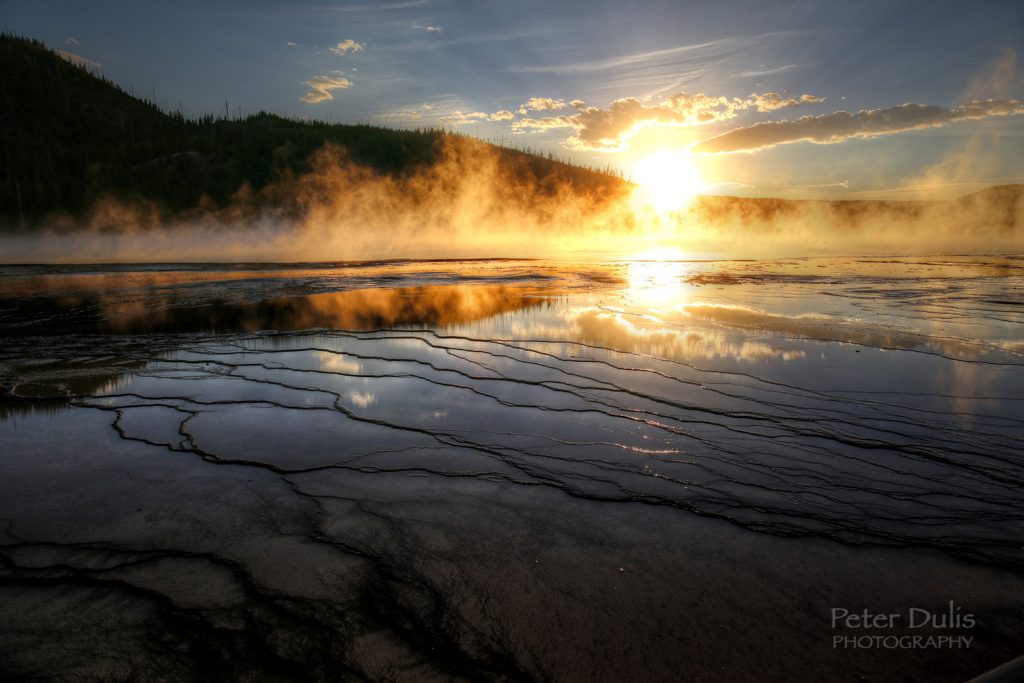
Grand Prismatic Spring – Midway Geyser Basin
The Grand Prismatic Spring is the largest hot spring in the United States, and the third largest in the world. It sits on a bed of rhyolitic rock which is a light-colored volcanic rock with high silica content. Different species of microbes’ flourish in specific temperatures and contain pigments which colour the surrounding spring edge. And when the sun goes down, the magic begins to happen. This photo was taken with my Canon 6D camera with an EF-11-24mm lens; in AV mode at 1/100 sec; f/8 with an ISO setting of 200
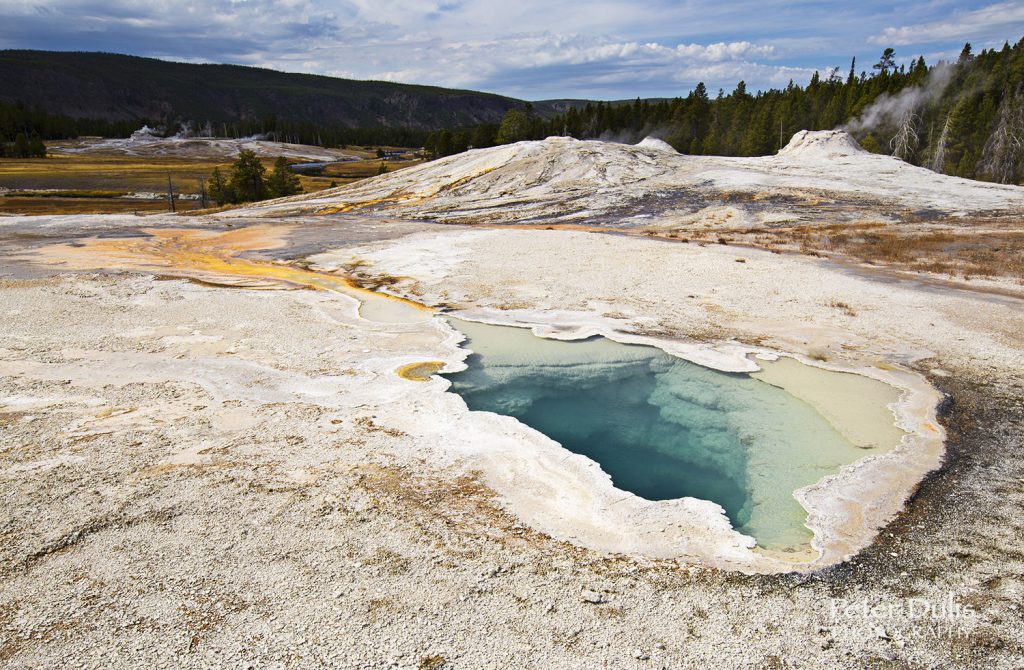
Heart Spring – Upper Geyser Basin
Heart Spring is a pretty pool of clear blue water, 15 feet deep and 10 feet across. This spring received its name because of the heart-like shape of the crater. Heart Spring has had temperature fluctuations from 150-202°F. This wide range of temperature has allowed microbial growth to form varicolored patterns. The blue water, orange algae and white sinter deposits make this spring magical. You can find this spring a short distance from Old Faithful Geyser. This photo was taken with my Canon 6D camera with an EF-24-105mm lens; in AV mode at 1/100 sec; f/11 with an ISO setting of 100.
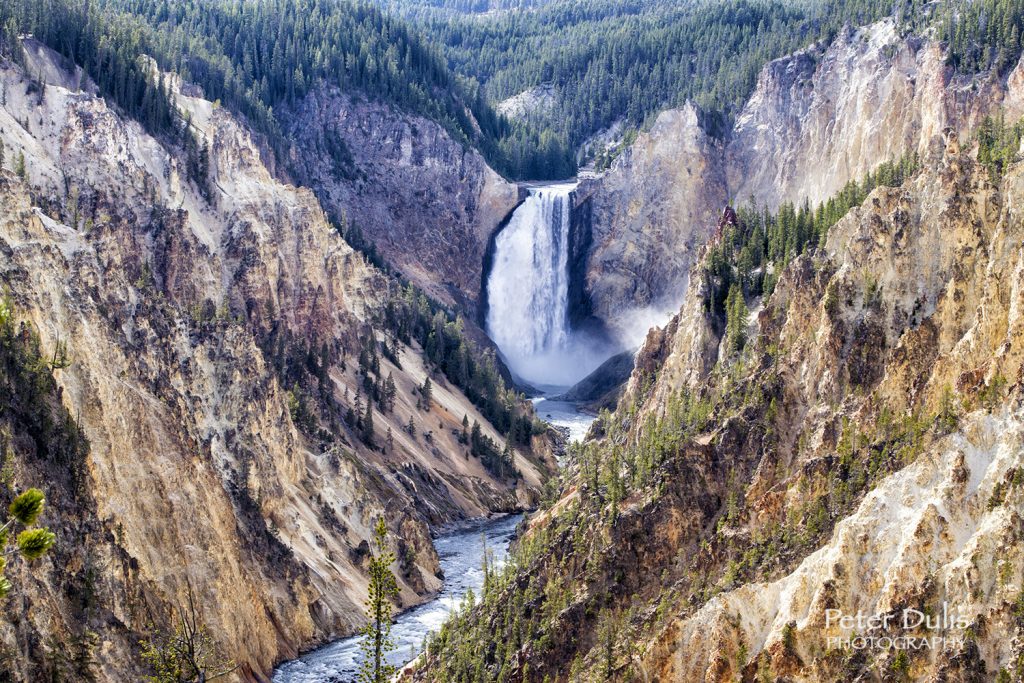
Grand Canyon of the Yellowstone Park
The Grand Canyon of the Yellowstone is the first large canyon on the Yellowstone River. Capture a classic photo of the Lower Falls from a place aptly named “Artist Point”. The Grand Canyon of the Yellowstone is the most breathtaking sight inside Yellowstone Park. I did not expect this when I looked down over the edge. It’s almost impossible to capture the beauty of it with a 1-dimensional image. Twenty miles long, the canyon is up to 4,000-feet wide and 1,200-feet deep in places. From several vantage points, you can view Lower Falls plunging steeply into the 308-foot-deep canyon. This photo was taken with my Canon 6D camera with an EF-70-200mm lens; in AV mode at 1/30 sec; f/20 with an ISO setting of 250, camera in tripod.
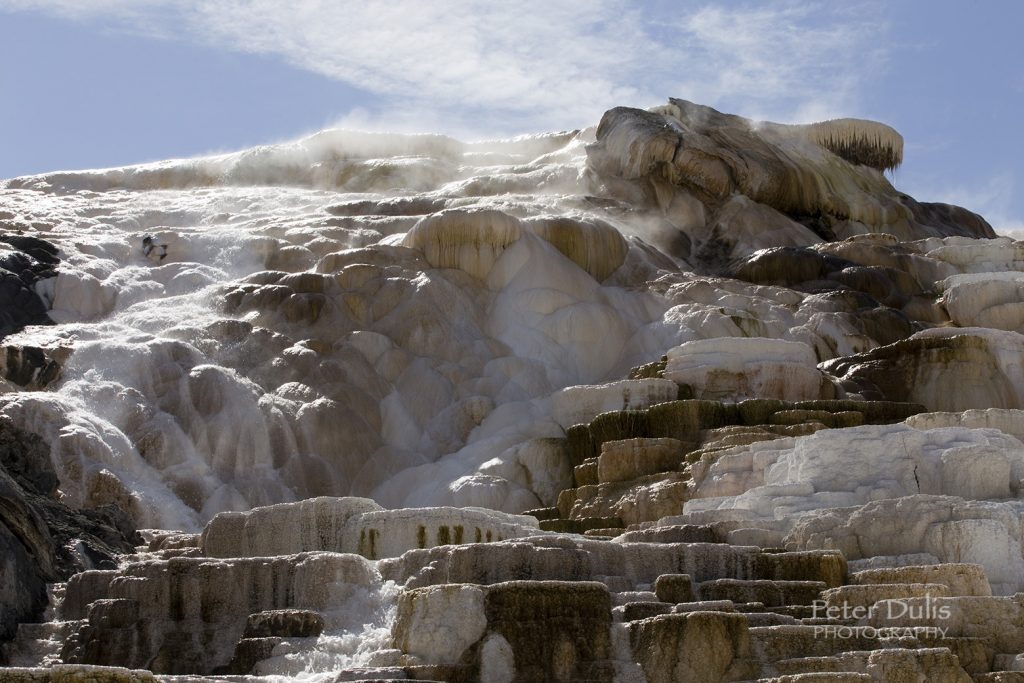
Mammoth Hot Springs – Lower Terrance
Mammoth Hot Springs are a must-see feature of Yellowstone National Park in part because they’re so different from other thermal areas in Yellowstone. It was created over thousands of years as hot water from the spring cooled and deposited calcium carbonate. Mammoth Hot Springs is the largest known carbonate-depositing spring in the world. Mammoth Hot Springs has two terrace boardwalks, the upper and lower. The lower terrace consists of nearly 50 hot springs scattered over a score of steplike travertine terraces which make for incredible photo opportunities. This photo was taken with my Canon 6D camera with an EF-70-200mm lens; in AV mode at 1/100 sec; f/18 with an ISO setting of 100.
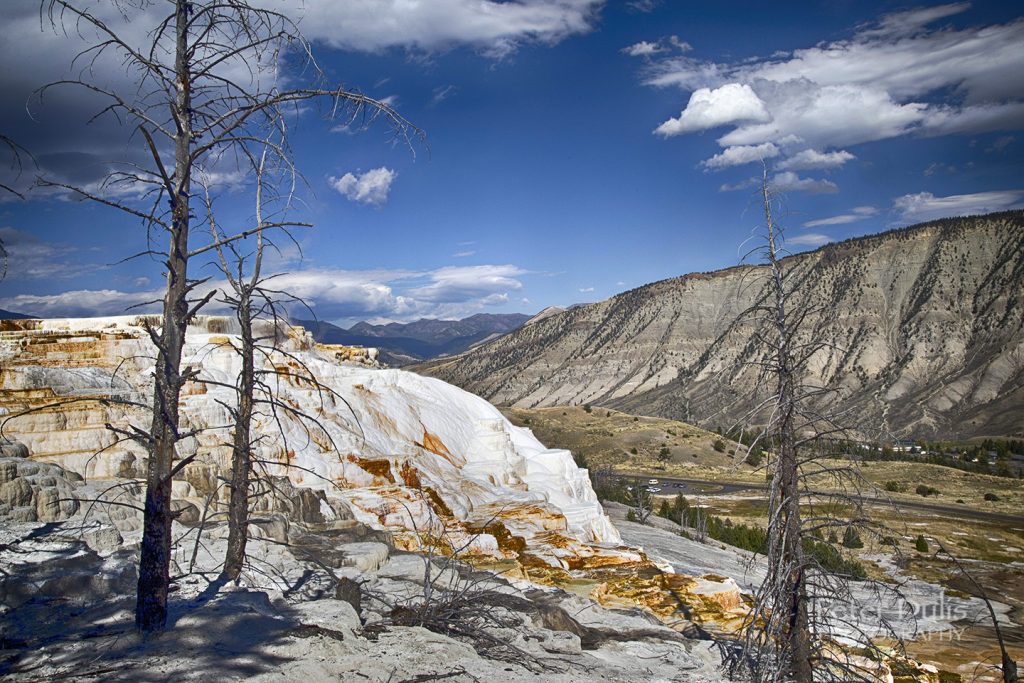
Mammoth Hot Springs – Upper Terrace
The natural beauty of these imposing travertine deposits, combined with the variegated hot springs, makes Mammoth Hot Springs one of the most interesting of photographic attractions. A drive along the loop in the upper terrace was a must as there was a lot to see and photograph. The road was narrow and one way; but there are pullovers along the road so you can stop to view the area and take photos. This dead trees on the side of Mammoth Hot Springs died in the heat and toxins from the steam vents. It was created over thousands of years as hot water from the spring cooled and deposited calcium carbonate. Mammoth Hot Springs is the largest known carbonate-depositing spring in the world. This photo was taken with my Canon 6D camera with an EF-24-105mm lens; in AV mode at 1/50 sec; f/18 with an ISO setting of 100.

White Dome Geyser – Lower Geyser Basin
Firehole Lake Drive is a one-way paved road through a section of the Lower Geyser Basin. It is located in between two other thermal areas, with the Fountain Paint Pots to the north and the Midway Geyser Basin to the south. There are many geysers to explore in this area, but one of my favorites was White Dome Geyser. The massive cone of White Dome Geyser shows that this geyser has been around for a long time. Eruptions are around 30 feet high, and usually last only a minute or so. This photo was taken with my Canon 6D camera with an EF-24-105mm lens; in AV mode at 1/160 sec; f/11 with an ISO setting of 125.
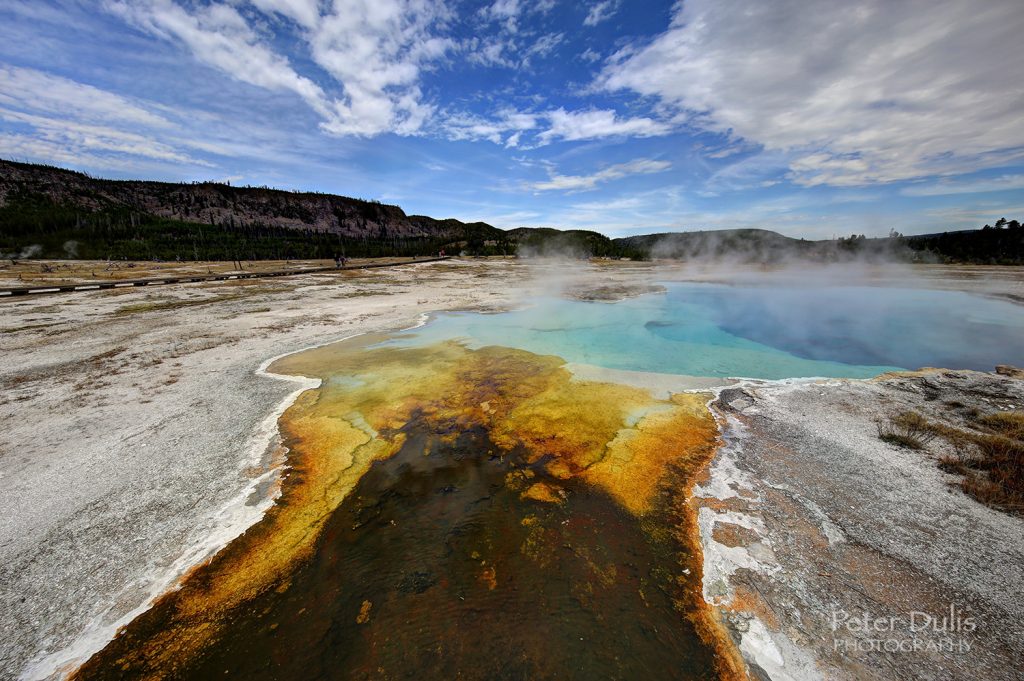
Sapphire Pool – Biscuit Basin
A jewel of Biscuit Basin, Sapphire Pool not only showed off a lovely hue, but its edges were also ornamented with hundreds of geyserite knobs. Visitors remarked that these knobs looked like biscuits—hence, Biscuit Basin. This photo was taken with my Canon 6D camera with an EF-11-24mm lens; in AV mode at 1/50 sec; f/11 with an ISO setting of 100.
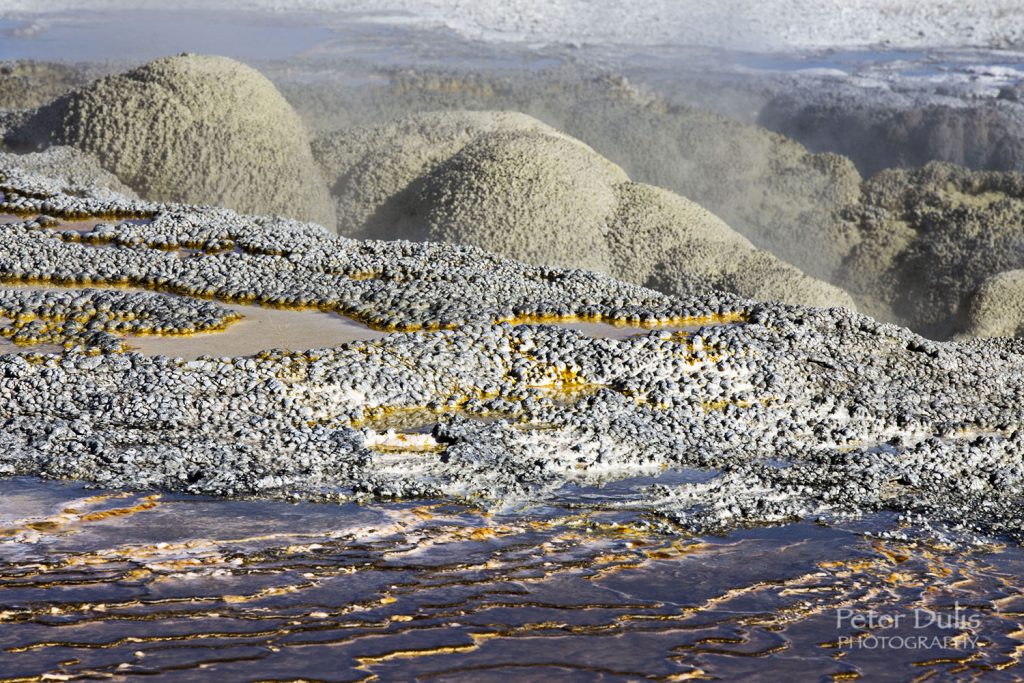
Shell Geyser in Biscuit Basin
Biscuit Basin contains a small collection of thermal features. Shell Geyser is a continually boiling pool in Biscuit Basin. The golden sinter lining of the crater resembles the shell of a bivalve, hence the name. Before an eruption, water in the crater begins to rise and may boil. Heavy churning then occurs, setting off the first small, weak eruption. As the eruptions subside water begins to lower and drain back into the crater. This photo was taken with my Canon 6D camera with an EF-70-200mm lens; in TV mode at 1/200 sec; f/16 with an ISO setting of 200.
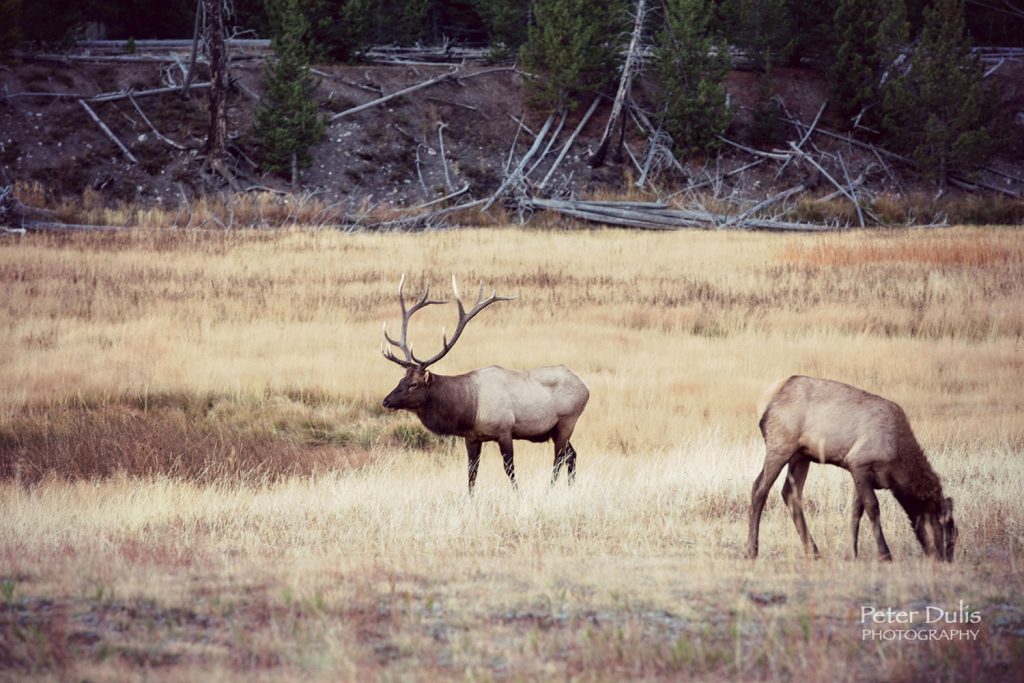
Yellowstone Elk – Madison Valley
Elk are most active early in the morning and late in the afternoon. Because grass is high on their menu, they commonly feed in large meadows. Here we found them in Madison valley early in the morning. Elk are famous for their mating calls, referred to as bugling. Each mature bull gathers as many females (cows) as possible prior to the breeding season, and then guards his harem from the other bulls. This photo was taken with my Canon 6D camera with an EF-70-200mm lens; in AV mode at 1/8 sec; f/8 with an ISO setting of 400.
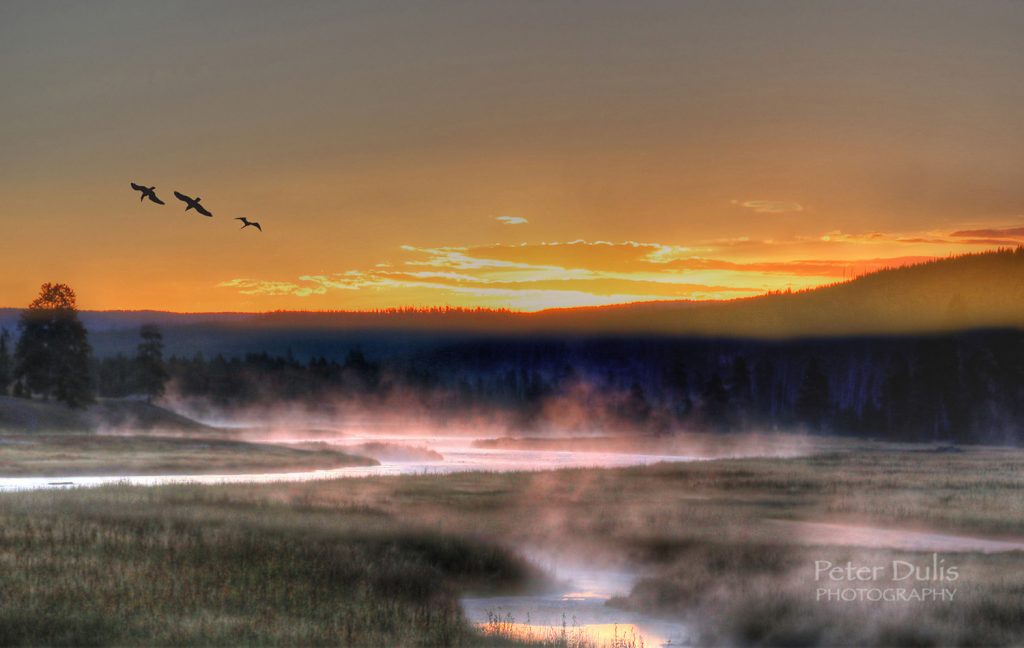
Madison River – Madison Valley
The Madison River is located on the west side of Yellowstone National Park. Fly fishing can be as good as it gets on this river and the fishermen were out in droves. In Charles Brooks book “The Living River” he aptly described the upper Madison as one of the loveliest river valleys anywhere. The river has steam rising from it that makes it appear to be smoking as if on fire. This photo was taken with my Canon 6D camera with an EF-24-105mm lens; in AV mode at 1/320 sec; f/8 with an ISO setting of 400.
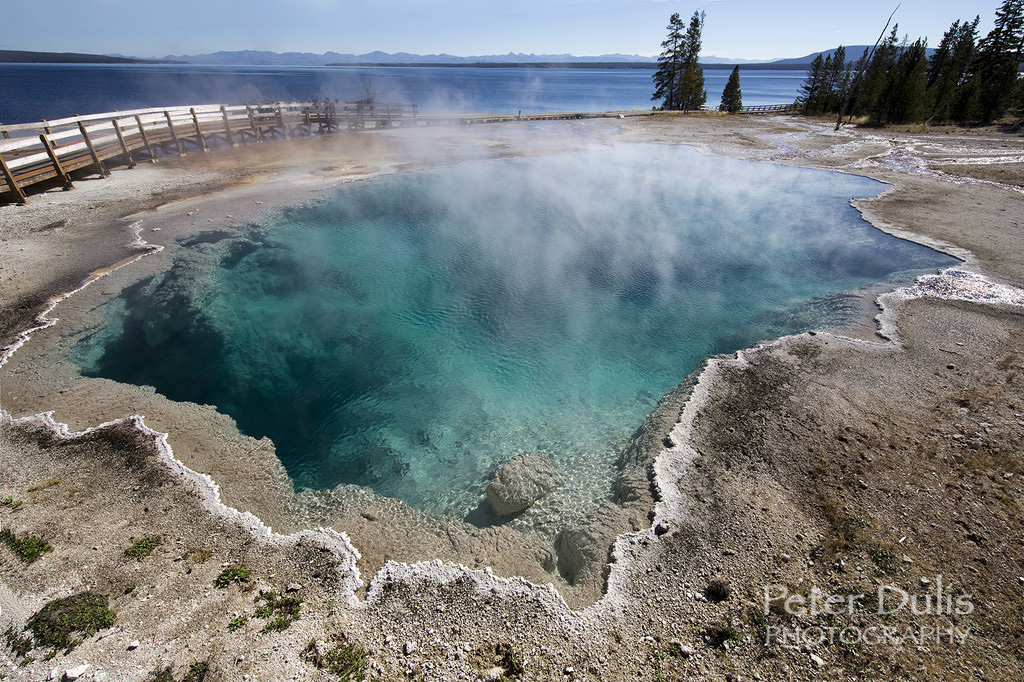
Black Pool Spring – West Thumb Geyser Basin
Located along the shores of Yellowstone Lake, West Thumb Geyser Basin is one of the chief beauties in that half of Yellowstone National Park. With temperatures around 132°F, its one of the largest springs in the West Thumb Geyser Basin. The dark-colored water is the combination of the natural, transparent blue of the water and the orange algae lining of the pool. Yellowstone Lake provides a beautiful backdrop for the Black Pool spring. This photo was taken with my Canon 6D camera with an EF-24-105mm lens; in AV mode at 1/320 sec; f/8 with an ISO setting of 400.
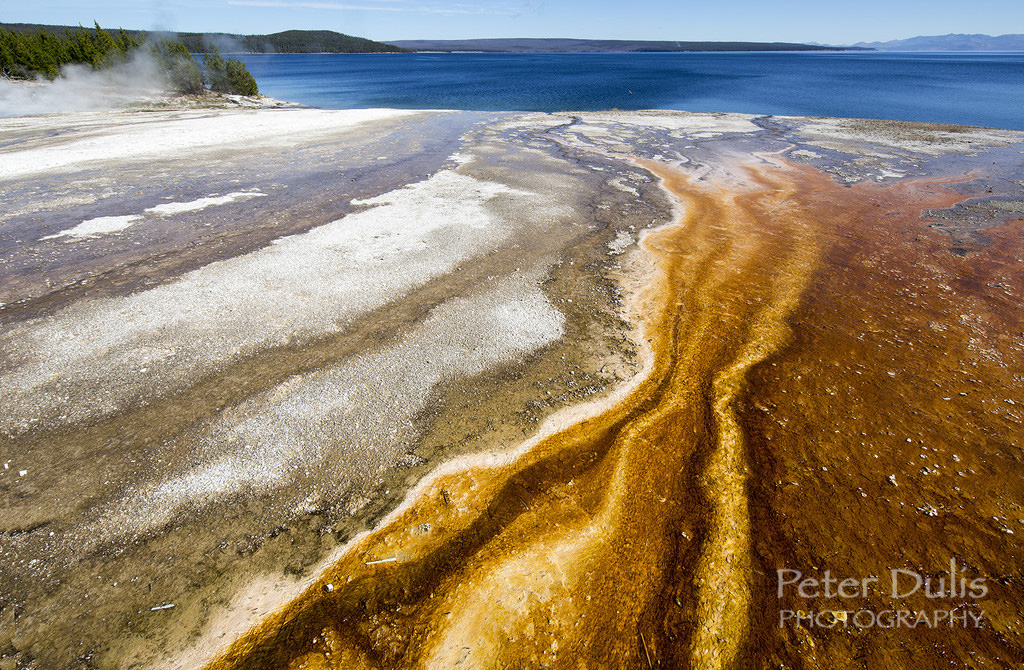
West Thumb – Geyser Basin
The West Thumb Geyser Basin, including Potts Basin to the north, is unique in that it is the largest geyser basin on the shores of Yellowstone Lake. The West Thumb of Yellowstone Lake was formed by a large volcanic explosion that occurred approximately 150,000 years ago. The hydrothermal features at West Thumb are found not only on the lake shore, but extend under the surface of the lake as well. This photo was taken with my Canon 6D camera with an EF-24-105mm lens; in AV mode at 1/320 sec; f/8 with an ISO setting of 400.
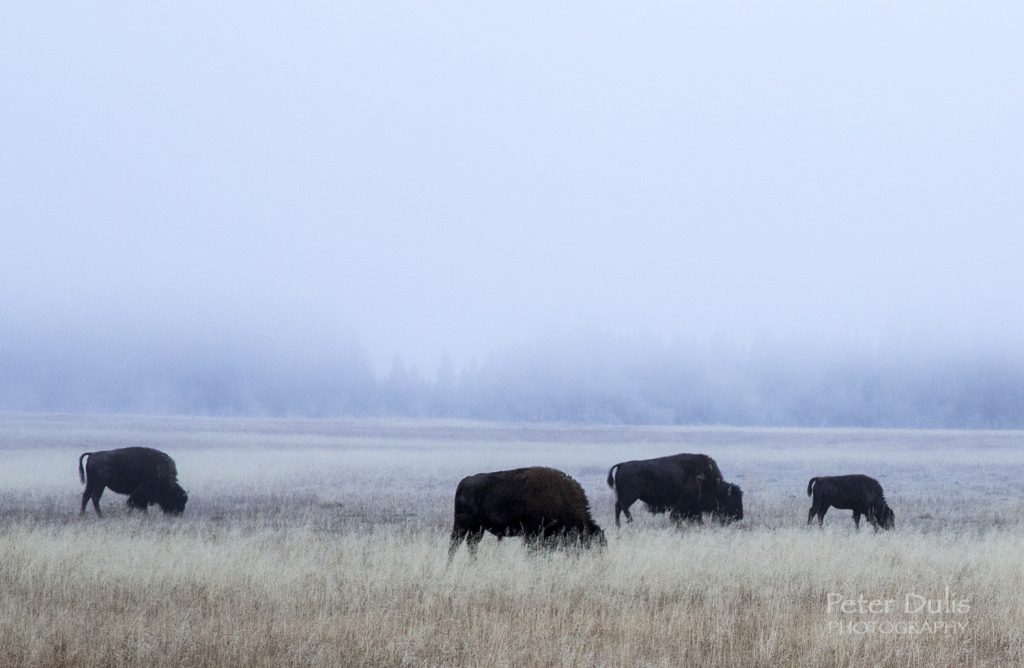
Foggy Bison Morning
The Yellowstone bison are probably the oldest and largest public bison herd in the United States, estimated in 2020 to be 4,800. You seem to run into them in most places. (literally if you are not careful driving) The central interior herd, can be found on the ranges from the Madison River valley into the Hayden Valley and Upper and Lower Geyser Basins. I got up nice & early this morning to catch the sunrise – problem was that there was no sun on the horizon, but thankfully the foggy morning brought out lots of bison on the range. This photo was taken with my Canon 6D camera with an EF-24-105mm lens; in AV mode at 1/100 sec; f/11 with an ISO setting of 1600.
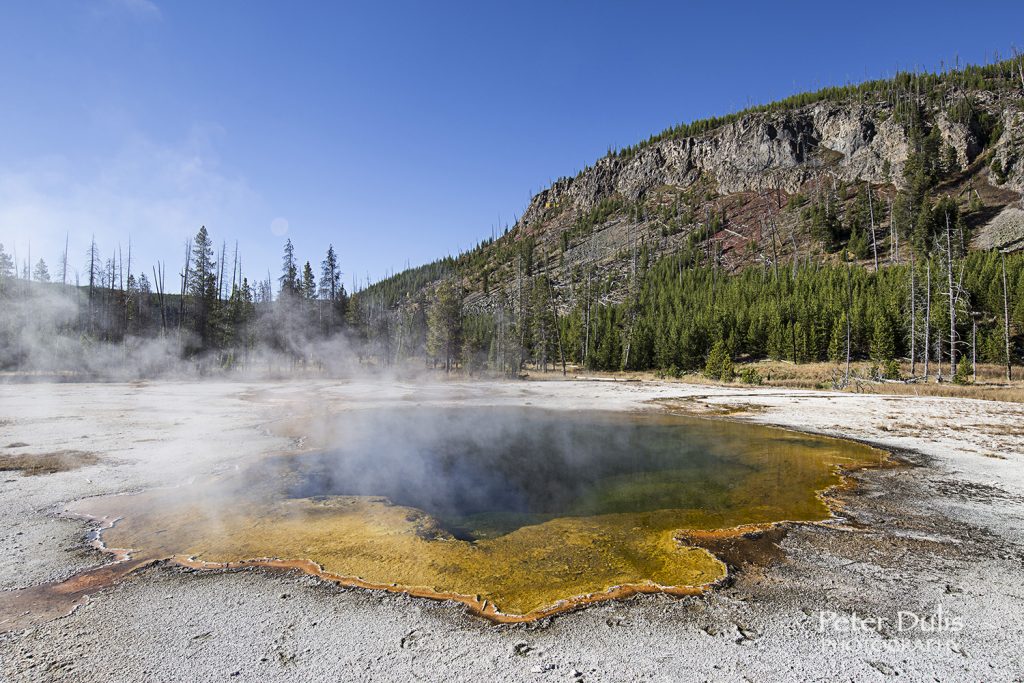
Emerald Pool – Black Sand Basin
Sometimes called “Emerald Spring,” this feature has been delighting visitors to the Park for centuries and is rightly one of the Park’s most famous springs. Emerald Pool is one of the most beautiful springs in the region. Truly this is a jewel, an emerald set in gold. Were there nothing else to be seen in the park, Emerald Pool would be worth the journey. This photo was taken with my Canon 6D camera with an EF-11-24mm lens; in AV mode at 1/160 sec; f/10 with an ISO setting of 100.
We hope you enjoyed our photo adventures to Yellowstone National Park and will stay in touch with us through our website – PhotographyAdventures.ca
FREE E-Book OFFER:
Travel & Photography Made EasyHere’s your chance to get your exclusive travel guide and photo tips in our 20 page e-book, along with regular travel tips delivered directly to your inbox.
- Discover amazing places to visit and how to photograph them (for non techie people)
With over 325,000 readers, TripAdvisor has hailed us as being “In the Top 1% of Popular Reviewers” plus “Top Photographer” – having visited over “90 Cities” – so here are our TOP 5 places to visit before it’s too late!

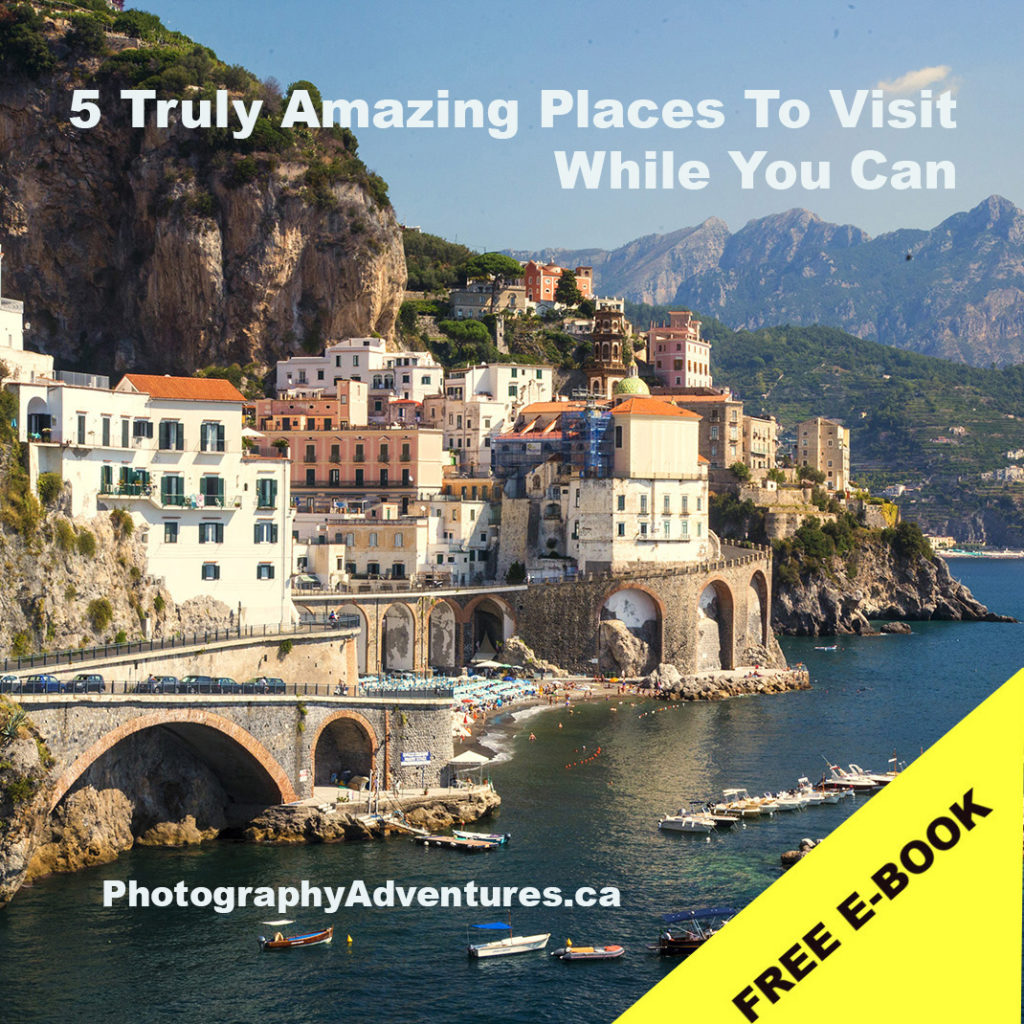
12 thoughts on “14 Iconic Locations within Yellowstone Park”
We’ve missed the opportunity to see this amazing place a few years back when family friends invited us to join their group to explore this natural wonder! Now we are more motivated to see it for ourselves! And would love to hike the area. Amazing images!!! Thank you for sharing!
Nelson&Paz
Thanks Nelson for the kind comments – You’ll love it there 🙂
Beautiful photos. Milanie and I (and another friend) went here last year. It was stunning – so different from where I usually photograph. Thanks for sharing!
Thanks for dropping by – glad you had a chance to see Yellowstone – there’s nothing quite like it 🙂
Thanks for this trip to Yellowstone.I have always wanted to go there.
Thanks Janis for your comment – If you get a chance to go, it will be an experience of a lifetime 🙂
Excellent photos Peter….!!
I hope I can go one day and shoot the Fire Waterfall and EL CAPITAN…
All the best !
Daniel
Thanks Daniel – Yosemite National Park “fire” waterfall + El Capitan is fabulous – I hope to visit some day as well
Breathtakingly beautiful captures and great info.
Thanks so much Diana for dropping by + leaving your kind comments –
Beautiful images!
Thanks Taffy for dropping by – much appreciated 🙂